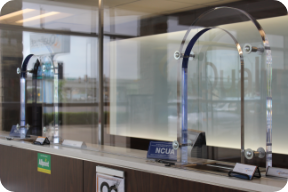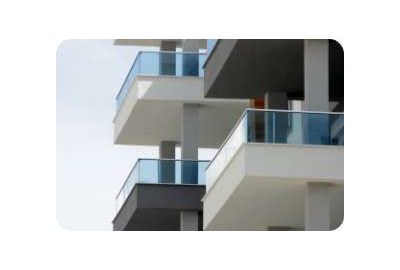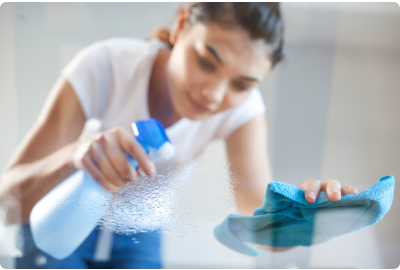Plexiglass is a thermoplastic homopolymer technically called polymethyl methacrylate but also known as acrylic. The fact that all three terms are used for the same material often leads to confusion about the difference between plexiglass and acrylic. There, of course, is no difference, but questions continue to abound.
Because of its wide array of physical properties, plexiglass is found in a broad range of applications. There are many uses of plexiglass, from aquariums to shower doors to bullet resistant barriers and more. This article will explore the properties, uses and pros and cons of plexiglass.
Table of Contents:
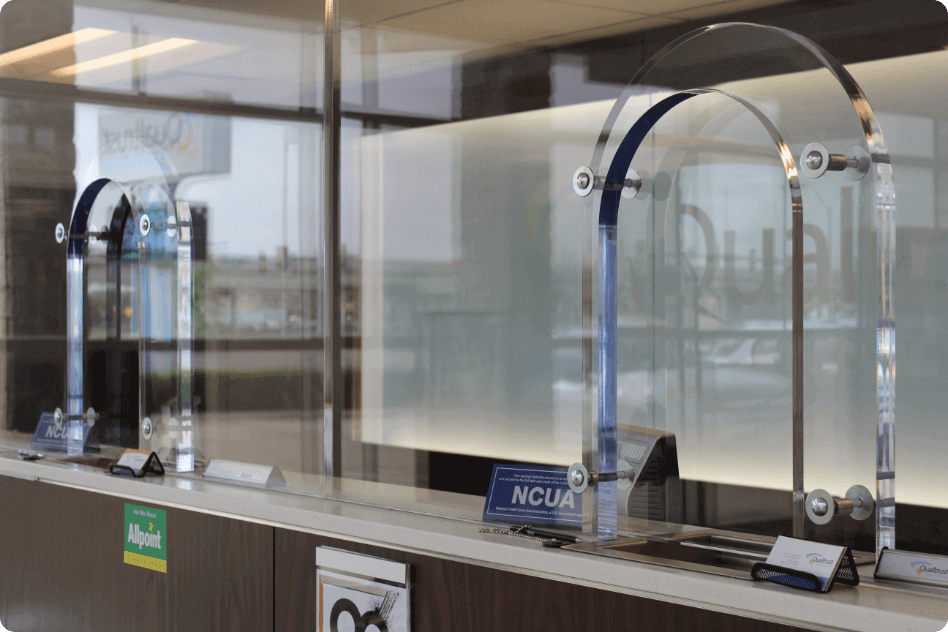
What Is Plexiglass?
Plexiglass is a plastic known for its transparency, durability and resistance to breakage. It's often used as a lighter, shatter-resistant alternative to traditional glass.
The material that would come to be known as plexiglass was first developed in the late 1920s and was brought to market by Rohm and Haas Company in 1933, originally under the brand name "Plexiglas," without the second 's.' It quickly gained attention for its unique properties and was initially used in a variety of applications, such as aircraft windows, retail displays and even periscopes in World War II. The use of plexiglass in aircraft was particularly revolutionary, as it was significantly lighter than glass, thus reducing a plane's overall weight and improving its performance.
Plexiglass is usually manufactured using one of two methods: cell casting and extrusion. In cell casting, the liquid monomer and catalyst are poured into a mold, where they polymerize to form a solid plexiglass sheet. This method typically produces material with excellent optical clarity and high resistance to weathering. In extrusion, the acrylic polymer material is fed through a heated barrel and extruded through a die to form sheets.
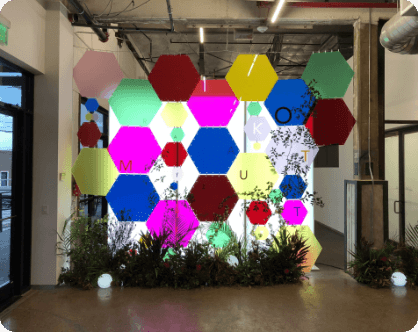
Properties of Plexiglass
Now that we've answered the question, "What is plexiglass?" let's look at acrylic's properties. Understanding the critical properties that make plexiglass a unique and highly versatile material is essential. These properties are the backbone of its myriad applications and offer valuable advantages over other materials like traditional glass and even different types of plastic.
Transparency
One of the most celebrated properties of plexiglass is its high level of transparency. It allows over 90% of light to pass through, providing better clarity than glass. This clarity makes it ideal for applications where visibility is crucial, such as windows, displays and lenses.
Light Weight
Plexiglass weighs significantly less than glass, making it easier to handle, transport and install. This lightness contributes to its extensive use in applications where reducing weight is essential, like in aircraft and automobiles.
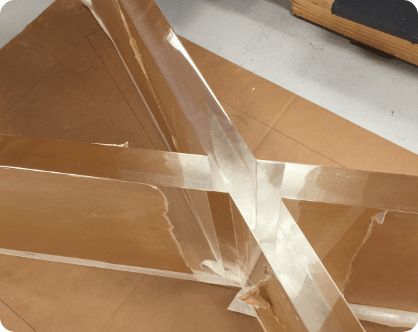
Shatter Resistance
Unlike traditional glass, plexiglass is highly resistant to shattering. When it does break, it tends to crack or splinter into larger, dull-edged pieces rather than forming dangerous shards. This makes it a safer option in environments where impact resistance is crucial.
Malleability
When heated, plexiglass becomes flexible, allowing it to be easily molded or bent into various forms. This malleability is particularly useful in applications requiring custom shapes, such as curved windows or specialized display cases.
Chemical Resistance
Plexiglass is resistant to a wide range of chemicals. This makes it suitable for use in laboratories and industrial settings where it may come into contact with various substances.
Thermal Properties
Plexiglass has better thermal insulation properties than glass, making it useful in applications where temperature regulation is essential, such as greenhouses or thermal windows.
What is Plexiglass Used For?
Plexiglass is an incredibly versatile material, used in many applications where traditional glass might have been used in the past. Its various properties, such as its transparency, light weight and shatter resistance, make it an ideal alternative to glass in many scenarios, expanding its utility far beyond what one might initially consider. Here are some common uses of plexiglass:
- Windows: From homes to skyscrapers, clear plexiglass is often used as temporary glazing because of its high level of clarity and resistance to shattering.
- Displays and signs: Retail stores and museums frequently use plexiglass for its transparency and malleability to create compelling, clear and safe displays. Sign designers prefer colored plexiglass for the wide range of options it provides.
- Vitrines and framing: Museums professional framers use plexiglass due to its unparalleled clarity, seamless glue joints, and polished edges.
- Automotive applications: Car windows, windshields and light covers are sometimes made from plexiglass, especially in high-performance vehicles where reducing weight is crucial.
- Aircraft components: Thanks to its shatter resistance and light weight, plexiglass is used in numerous aircraft applications, such as cabin windows and instrument panels.
- Aquariums: The shatter-resistant nature of plexiglass makes it ideal for aquarium tanks.
- Protective barriers: From machine guards in factories to sneeze guards at food counters, plexiglass serves as a protective barrier in various settings.
- Furniture and interior design: Its malleability and durability make decorative plexiglass a favorite of furniture makers and interior designers.
- Mirrors: Reflective plexiglass is a popular choice for mirrors in high-traffic or safety-conscious areas, such as schools and gyms.
- Construction: Plexiglass can be found in construction applications like roofing and canopies due to its strength and impact resistance.
- Wedding accessories: Plexiglass adds just the right touch to a wide range of wedding decor, as well as cake stands, invitations, seating charts and table numbers.
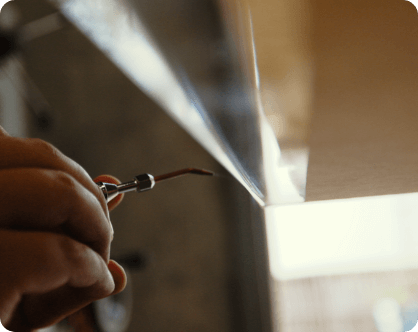
Pros and Cons of Plexiglass
When choosing material for any application, weighing the benefits and drawbacks is crucial to make an informed decision. Plexiglass, despite its myriad uses and beneficial properties, has its limitations. Below, we explore the pros and cons of using Plexiglass.
Pros
- Lighter than glass: One of the most significant advantages of plexiglass is its light weight compared to traditional glass. This is particularly beneficial for applications where weight is a critical factor, such as in aircraft, automobiles or large installations. The reduced weight not only makes handling and transportation easier but can also reduce costs associated with heavy lifting equipment.
- Resistance to impact: Plexiglass is remarkably shatter-resistant, making it ideal for environments where safety is a concern or where the material is likely to be subjected to impact. Unlike glass, which can shatter into dangerous shards, plexiglass tends to crack or break into larger, less sharp pieces, decreasing the risk of injury.
- Malleability: When heated, plexiglass becomes pliable, allowing for a broad array of forms and shapes that can't be achieved with traditional glass. This malleability opens a world of creative possibilities, from intricate display cases to uniquely curved windows.
- Transparency: Plexiglass offers excellent clarity, allowing over 90% of light to pass through. This makes it nearly as transparent as optical glass and a perfect choice for applications where visibility is critical, such as windows and signage.
Cons
- Scratchability: One downside to plexiglass is its susceptibility to scratches. While it fares well against impact, it is not as resistant to surface abrasions as some other materials. However, certain coatings and treatments can improve its scratch resistance.
- Price: High-quality plexiglass can be more expensive to purchase than standard glass, especially if you require forms that are thicker or have been treated for additional properties like scratch resistance or reduced glare. However, when its durability, ease of installation and simplified maintenance are considered, plexiglass often has a lower total cost of ownership.
Specialized Treatments for Plexiglass
Plexiglass is not a one-size-fits-all material; its inherent versatility allows for various treatments and specializations that tailor its properties to specific needs. Whether you're looking to reduce glare, prevent fogging or improve durability, there are different types and treatments of plexiglass that can be applied to meet these requirements.
- Anti-reflective treatments: These coatings can be applied to plexiglass to minimize glare and reflections, making it ideal for use in storefront displays, picture frames and even eyewear. This treatment enhances the visibility and readability of images or text behind the plexiglass.
- Anti-fog coatings: These are particularly useful in applications where changes in temperature or humidity can cause condensation on the material. These coatings prevent the water droplets from forming, thus maintaining clear visibility. This treatment is commonly used in bathroom mirrors and vehicle windows.
- UV resistance: This treatment blocks out harmful ultraviolet rays, making plexiglass suitable for outdoor applications such as skylights and car windows, where it can keep sun exposure from fading interiors.
Frequently Asked Questions About Plexiglass
As a player in the $3.7 billion plexiglass sheet market, Regal Plastics is well-positioned to provide the answers you need. Read the following questions for the information you're looking for.
How Strong Is Plexiglass?
Is Plexiglass Heat-Resistant?
Does Plexiglass Bend?
What Material Is Plexiglass?
Is Plexiglass Durable?
Trust Your Plexiglass Needs to Regal Plastics
Now that you know the answers to questions like "What is plexiglass?" and "What is plexiglass used for?" you're ready for the next step. Regal Plastics is a trusted provider of a wide range of plexiglass. Our inventory ranges from clear to colored to decorative plexiglass and so much more. Contact us today for the plexiglass that meets your requirements.
REQUEST A QUOTE